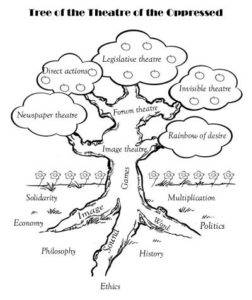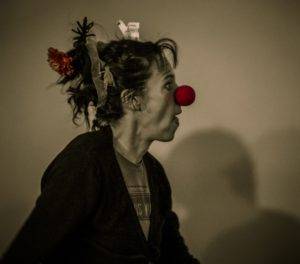As I consider a recent production “The Pirates of Penzance” and the commedia masks I’ve made, I am reminded that the Performing Arts have been a form of protest since people gathered around a campfire and a storyteller wove critique into his or her tale, since the first time homo erectus cracked a joke at the expense of someone with more social power. Although the Performing Arts certainly include music (and I would count the haunting soundscape of the Casserole Protests, with their conscious ‘symphonizing’ of rhythm, volume, and melody, in this category), my emphasis here will be on protest actions that involve movement and theatre.
A subset of what is generally termed “Theatre for Social Change,” performance protest comes in many forms. For example, the design of the Pots and Pans protests empowers people to join—no preparation, walking, or revealing your identity required. Maximizing participation increases the message of solidarity, and the general public, as they become aware of the performance protest, may self-select to become a participant or an audience member. Sound-based performances are PERFECT for those parameters!
But what if your message is more specific? What if there are specific ideas or relationships, data or events that the initiators want to bring to light? This is where the realm of movement might be your best bet. These types of theatre exist all over the world.
 The types of theatre protest
The types of theatre protest
Plays
Of course, there are many plays—comic and tragic—that are intended to illuminate an event or idea, and there are companies galore that specialize in these works. Most are in a “Theatre Companies” list of any major city.
Populist Theatre
This is the term used to describe empowering performance projects by which a small group of people elicit stories and images from a specific community or within the public at large, and, working with community stakeholders, develop a pageant-like public performance. Bread and Puppet always uses this form, and it is also often a part of Mayworks Festival.
Commedia dell’Arte
One of my favorite forms of protest, commedia dell’arte arose in Italy in the 1500s , empowering the peasantry with information and comic satire while providing a rollicking good time. The relationships, plot devices, and comic lazzis have become classic delightful and effective structures, which build your own hilarious and pointed piece. Historically, commedia companies are on the move, in part because they make too much trouble.
Clowning
There are so many clown forms!! Basically, clowns reveal the absurdity of what we do, make us laugh at ourselves at our worst, and create longing for ourselves in our best. There are so many incredible clowns–some of my favorites are Mump & Smoot, Morro and Jasp, and Bill Irwin.
Interactive Sociodrama
To quote the late great Augusto Boal (speaking in this moment of the subtype known as ‘Forum Theatre’), “Forum-Theatre presents a scene or a play that must necessarily show a situation of oppression that the Protagonist does not know how to fight against, and fails. The spect-actors are invited to replace this Protagonist, and act out—on stage and not from the audience—all possible solutions, ideas, and strategies. The other actors improvise the reactions of their characters facing each new intervention, so as to allow a sincere analysis of the real possibilities of using those suggestions in real life. All spect-actors have the same right to intervene and play their ideas. Forum-Theatre is a collective rehearsal for reality.”
There are other kinds of protest performance, including other forms of street theatre, environmental theatre, and Guerilla theatre, as well as many solo performance artists and story tellers whose work is based in protest, but the above are a good place to start!
